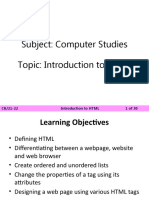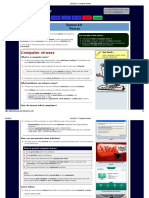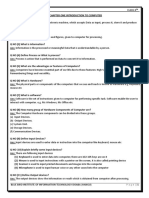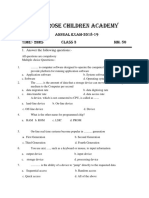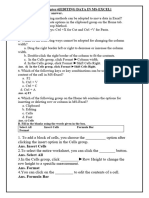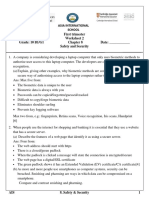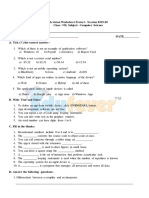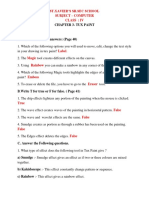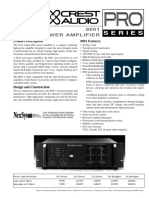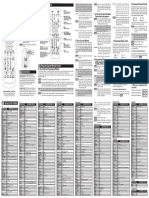Chapter 1 - Hardware Concepts Type A: Very Short Answer Questions
Uploaded by
samyakChapter 1 - Hardware Concepts Type A: Very Short Answer Questions
Uploaded by
samyakChapter 1 - Hardware Concepts
Type A: Very Short Answer Questions
1.
What is computer?
Ans: A computer is an electronic device that can perform a variety of tasks according to the given instructions.
2
What are the functional components of a digital computer?
Ans:
1. Input unit
2. Output unit
3. Central Processing Unit
4. Memory
3
What are the components of CPU? What is the function of control unit of CPU?
Ans: The CPU has two components:
1. Arithmetic Logic Unit (ALU)
2. Control Unit (CU)
The function of control unit of CPU is the program execution i.e., carrying out all the instructions stored in the
program.
4
What role does the input unit play in a computer? What role does the output unit play in a computer?
Ans: The input unit takes the input and converts it into binary form so that it can be understood by the computer.
The output coming from the CPU is in the form of electronic binary signals which needs conversation in some form
which can be easily understood by human beings i.e., characters, graphical or audio visual.
5
What is the function of ALU?
Ans: The ALU performs all the four arithmetical (+, -,*, /) and some logical (<, >, =, <=, >=, <>) operations.
6
What is the function of main memory? What are the measuring units of memory?
Ans: The memory temporarily holds the data and information during processing.
The smallest unit of memory is a byte (8 bits). A byte can store one character in binary form. Other measuring units
are 1 kilobyte (KB) equal to 1024 (210) bytes, 1 Megabyte (MB) equal to 1024 KB, 1 Gigabyte (GB) equal to 1024 MB
and 1 Terabyte (TB) equal to 1024 GB.
7
Which of the following is not hardware: (a) Hard disk (b) Printer (c) Keyboard (d) CPU (e) Assembler (f) Program to
print table of 13?
Ans: (f) Program to print table of 13.
8
What do you mean by the terms Hardware, Software, Firmware?
Ans: Hardware: These are the physical or tangible components of a computer.
Software: It is a set of programs required to run the hardware and govern the system operations.
Firmware: Firmware is the prewritten programs permanently stored in read-only memory.
9
What are the main types of software?
Ans: Following are the main type of software:
1. Operating System
2. Language Processors
3. Application Software
10
What are the functions of operating system and language processor? Give examples.
Ans: Operating System: Loads necessary programs (into the computer memory) which are required for proper computer
functioning. Example of operating system are Single user, multiuser, batch processing, multiprocessing etc.
Language processor: Process an HLL (High Level Language) program so as to make it understandable to the computer.
Examples of language processor are Interpreter, compiler, Assembler.
11
What is the function of assembler, compiler and interpreter?
Ans: Assembler: Converts the program written in assembly language into machine language.
Compiler: Converts the HLL program into machine language but the conversion manner is different.
Interpreter: Converts an HLL program into machine language by converting and executing it line by line.
12
What do you understand by application software?
Ans: Application software is the set of programs necessary to carry out operations for a specified application.
13
What are the main limitations of computers?
http://cbsecsnip.in
Page 1 of 13
Ans: Following are the main limitation of computer:
1. Lack of Decision Making Power.
2. IQ Zero
14
What are different categories of a computer?
Ans: Following are the different categories of a computer:
1. Digital Computers
2. Analog Computers
3. Hybrid Computers
15
Which type of computer contains several processors running together? Give an example of such type of computer.
Ans: Super computer contains several processors running together. Examples are CRAY X-MP-14, CDC-205, ETA GF-10.
16
write the full forms of the following terms: VDU, MICR, OMR, LCD, OCR, DMP, CRT, CD-ROM, CD-R, DVD, DVD-R
Ans: VDU: Visual Display Unit
MICR: Magnetic Ink Character Reader
OMR: Optical Mark reader
LCD: Liquid crystal display
OCR: Optical Character reader
DMP: Dot Matrix Printer
CRT: Cathode Ray Tube
CD-ROM: Compact Disk-Read Only Memory
CD-R: Compact Disk Recordable
DVD: Digital Video Disk
DVD-R: Digital Video Disk-Recordable
17
Name some pointing devices.
Ans: 1. The Mouse
2. The Light Pen
3. Touch Screens
4. Joystick
18
What are two categories of impact printers? What is the advantage of non-impact printers over impact printers?
Ans: Following are two categories of impact printers:
1. Line printers
2. Dot Matrix Printer
Non-impact printers are fast compared to an impact printer.
19
Out of the following devices, write whether they are input devices, output devices or storage devices. Also write
their function.
(i) Light pen (ii) Flatbed plotter (iii) Drum printer (iv) Joystick
(v) OMR
(vi) Web camera (vii) Optical disk (viii) Magnetic disk
(ix) MICR
(x) DVD
Ans: Input Devices
1. Light pen: Light pen is used to draw images on the screen. With the movement of the light pen over the
screen, the lines are drawn.
2. Joystick: Joystick is used to play games as it controls the movement of objects quickly and accurately. In some
cases joystick are used to control the velocity of the screen cursors movement rather than its absolute
position.
3. Web camera: It is used to generate images that can be accessed by and displayed on web browsers through a
server.
4. MICR: It reads character by magnetizing the ink and by examining the shape of the character. MICRs are
mainly used by banks.
5. OMR: Optical Mark Reader (OMR) uses infra-red light to scan marks on prepared forms such as multiplechoice examination answer sheets or lottery tickets.
Output Devices
1. Drum printer: An old line printer technology that used formed character images around a cylindrical drum as
its printing mechanism.
http://cbsecsnip.in
Page 2 of 13
20
Ans:
21
Ans:
22
Ans:
23
Ans:
24
Ans:
25
Ans:
26
Ans:
27
Ans:
28
Ans:
2. Flatbed plotter: A flatbed plotter is a device that uses pens to draw graphics and pictures, instead of printing
heads, nozzles, and ink cartridges used in typical printers.
Storage Devices
1. DVD: It is used for storing information in digital form.
2. Optical disk: It Stores data optically & used laser to read/write.
3. Magnetic disk: It Stores data in magnetic form.
Briefly discuss the printing mechanism of (i) laser printer (ii) inkjet printer.
(i)
Laser printer Laser printers are non-impact printers which can print text and images in high speed and
high quality resolution, ranging from 600 to 1200 dpi.
(ii)
Inkjet printer An inkjet printer is any printer that fires extremely small droplets of ink onto paper to
create impression of text or images. The inkjet printers direct a high-velocity stream of ink toward the
paper.
Compare the drum plotter and flat bed plotter.
The drum plotters are generally smaller than flatbed plotters. The drum plotters have lower resolutions than flatbed.
Briefly explain (i) VDU (ii) LCD.
(i)
VDU Stands for "Visual Display Unit." A VDU displays images generated by a computer or other
electronic device.
(ii)
LCD Stands for "Liquid Crystal Display." LCDs are super-thin displays that are used in laptop computer
screens and flat panel monitors.
What are the two types of RAM? Name various types of ROMs. Write their names in full form.
Types of RAM
1. SRAM Static Random Access Memory
2. DRAM Dynamic Random Access Memory
Types of ROM
1. PROM Programmable Read-Only Memory
2. EPROM Erasable Programmable Read-Only Memory
3. EEPROM Electrically Erasable Programmable Read-Only Memory
How are magnetic disks different from optical disks?
Magnetic disk
Optical disk
Stores data in magnetic form
Stores data optically & used laser to read/write
It is affected by magnetic field.
It is not affected by magnetic field.
It has high storage capacity.
It has less storage than hard disk.
Define the following terms: (i) cylinder (ii) tracks (iii) sectors.
(i)
Cylinder A cylinder is a location made up of the same track on all the platters.
(ii)
Tracks Concentric circles on the magnetized surface of the magnetic disks are known as Tracks.
(iii)
Sectors The tracks on the disk surface are divided into invisible segments known as Sectors.
What are optical disks?
Optical disk is any storage media that holds content in digital format and is read using a laser assembly is considered
optical media. The types of optical disks are CDs, and DVDs.
What is communication bus? What are its types?
Communication bus is a collection of wires that transmit binary numbers, one bit per wire. Microprocessor
communicates with memory and other devices (input and output) using three buses:
Address Bus
Data Bus
Control Bus
What is port? Name some port types briefly.
Ports are used to connect external devices to the computer.
Several types of ports are there, example of some
1. Network Ports It is an address (16-bit address) within a computer, usually associated with a particular
application protocol.
http://cbsecsnip.in
Page 3 of 13
2. Serial Ports They transfer data serially a bit at a time Needs only wire to transmit 8 bits, it is also known as
COM port.
3. Parallel Ports A byte (8-bit) is transferred at a time in parallel port, 8-bits are transmitted parallel to each
other. Parallel ports are very commonly used for printer, scanner, CD writer and many other external devices.
29
Name two ports that allow wireless connection of devices.
Ans:
1. InfraRed Port (IR port)
2. Bluetooth
30
What do you understand by IPO cycle?
Ans: IOP Input Output Process. Every task follows this Input-Process-Output (IOP cycle). A computer also follows the I-O-P
cycle i.e., it needs certain input, carries out a process and produces the output.
Type B: Short Answer Questions
1
Ans:
2
Ans:
3
Ans:
What is computer? What are its characteristics?
A computer is an electronic device that can perform a variety of tasks according to the given instructions.
Characteristics of computer:
1. Speed
2. Accuracy
3. Versatility
4. Reliability
5. Power of Remembering
6. No I.Q
7. Common Data Used
8. Diligence
9. Storage
Briefly explain the significance of Input-Process-Output Cycle.
Example :
Input Your desire to make a phone call at number 7455165
Process Dialing up the number.
Output Chat with your friend.
In above example undergo these three stages. The first stage is called input stage. The second stage is called process
stage and the third stage is called output stage. Certain input is needed to accomplish a task; a process is carried out
on the input to obtain the output.
Every task follows this Input-Process-Output (IOP cycle). A computer also follows the I-O-P cycle i.e., it needs certain
input, carries out a process and produces the output.
Briefly explain the basic architecture of a computer.
Computer follows input-process-output cycle, the first stage is performed in computer by input unit, second stage is
performed by its central processing unit and the third stage is performed by output unit. Thus the basic structure of
computer is as shown below.
1. Input Unit
The input unit is formed by the input devices attached to the computer. Example of input devices and media
are: keyboard, mouse, joystick etc.
2. Central Processing Unit (CPU)
The CPU is the control center for a computer. It guides, directs and governs its performance. It is the brain of
the computer. The CPU has two components which are responsible for different functions. These two
components are its Control Unit (CU) and Arithmetic Logic Unit (ALU).
3. Output Unit
The output unit is formed by the output devices attached to the computer. Some popular output devices are
VDU (Visual Display Unit), printer, plotter, speech synthesizer and coder etc.
4. The Memory
The memory of computer is often called main memory or primary memory. It is generally the third
component of CPU. The memory of computer is more like a predefined working place, where it temporarily
http://cbsecsnip.in
Page 4 of 13
4
Ans:
5
Ans:
6
Ans:
7
Ans:
8
Ans:
9
Ans:
10
Ans:
keeps information and data to facilitate its performance.
What do you understand by input unit? What is its significance?
The input unit is formed by the input devices attached to the computer. An input unit takes the input and converts it
into binary form so that it can be understood by the computer. Example of input devices and media are: keyboard,
mouse, magnetic ink character reader (MICR), optical mark reader (OMR), optical character reader (OCR), joystick etc.
What is the function of CPU in a computer system? What are its subunits?
CPU guides, directs and governs its performance. It is the brain of the computer.
Following are the subunits of CPU:
1. Control Unit (CU)
2. Arithmetic Logic Unit (ALU).
What functions are performed by the control unit? Can we call it the control centre of computer system? Why?
The function of control unit of CPU is the program execution i.e., carrying out all the instructions stored in the
program. Yes we can call it the control centre of computer system because it guides, directs and governs its
performance. It is the brain of the computer.
What functions are performed by the ALU? Is it an independent unit? If not, which unit does ALU work in
coordination with?
The ALU performs all the four arithmetical (+, -, *, /) and some logical (<, >, =, <=, >=, <>) operations. No, it is not an
independent unit. ALU works in coordinate with CU.
Distinguish between (i) Input unit and Output unit (ii) CPU and ALU (iii) Data and Information.
(i)
Input unit and Output unit
Input
Output
An input device is a component used to feed An output device gives processed
information to a computer.
information back to the user.
Example: keyboard, mouse, magnetic ink
Example: VDU (Visual Display Unit), printer,
character reader (MICR), optical mark reader
plotter, speech synthesizer and coder etc.
(OMR), optical character reader (OCR),
joystick etc.
(ii)
CPU and ALU
CPU
ALU
The CPU is the master driver of a computer.
The ALU (Arithmetic-Logic Unit) is generally a
subsection of the CPU (Central Processing
Unit).
The CPU guides, directs and governs its
The ALU performs arithmetical and logical
performance.
operations.
(iii)
Data and Information
Data
Information
Data is raw, unorganized facts that need to be
When data is processed, organized, structured
processed. Data can be something simple and
or presented in a given context so as to make it
seemingly random and useless until it is
useful, it is called Information.
organized.
Each student's test score is one piece of data.
The class' average score or the school's
average score is the information that can be
concluded from the given data.
What is the function of output unit in a computer system? Give examples of some output devices.
The output coming from the CPU is in the form of electronic binary signals which needs conversion in some form
which can be easily understood by human beings i.e., characters, graphical or audio visual. This function of
conversation is performed by output units.
Example of output devices are VDU (Visual Display Unit), printer, plotter, speech synthesizer and coder etc.
What role does memory play in the functioning of computer system?
The memory of a computer is more like a predefined working place, where it temporarily keeps information and data
to facilitate its performance.
http://cbsecsnip.in
Page 5 of 13
11
Ans:
12
Ans:
13
Ans:
14
Ans:
15
Ans:
What is a bit? What is binary code?
A bit is an elementary unit of the memory.
A Binary code is a way of representing text or computer processor instructions by the use of the binary number
system's two-binary digits 0 and 1.
Define each of the following:
(a) nibble (b) byte (c) kilobyte (d) megabyte (e) gigabyte (f) terabyte.
(a) nibble A group of 4 bits is called a nibble.
(b) byte A group of 8 bits is called a byte.
(c) kilobyte A group of 1024 bytes is called a kilobyte.
(d) megabyte A group of 1024 kilobyte is called megabyte.
(e) gigabyte A group of 1024 megabyte is called gigabyte.
(f) terabyte A group of 1024 gigabyte is called terabyte.
What is the meaning of the term volatile primary memory? What can be done to overcome the problems of
volatility?
The meaning of the term volatile primary memory is temporarily primary memory. RAM is the volatile primary
memory. We can use ROM to overcome the problems of volatility.
Distinguish between internal and external memory.
Internal Memory
External Memory
Internal memory stores information on your computer. External memory stores it on a portable device.
Example: ROM, RAM.
Example: Memory stick, MultiMedia card.
Draw a block diagram of the main units of a computer hardware system.
INPUT
UNIT
CENTRAL
PROCESSING UNIT
(CPU)
MAIN MEMORY
OUTPUT
UNIT
Storage
Devices
16
Ans:
What are the differences between hardware, software and firmware?
Hardware
Software
Hardware are the physical
Software are the computer
tangible components of a
programs that govern the
computer system.
operation of computers.
17
Ans:
What are the software classifications? Discuss their functioning in brief.
Software can be classified into three categories:
1. Operating System loads necessary programs (into the commuter memory) which are required for proper
computer functioning.
2. Language processors Process an HLL (High Level Language) program so as to make it understandable to the
computer.
3. Application software These are the programs written by the programmers to enable computer to perform a
specific task such as inventory control, medical accounting, financial accounting, result preparation, railway
reservation, billing etc.
Explain briefly hardware and software.
18
http://cbsecsnip.in
Page 6 of 13
Firmware
Firmware is the prewritten
programs permanently stored
in read-only memory. These
configure the computer and are
not easily modifiable by the
user.
Ans:
19
Ans:
20
Ans:
21
Ans:
22
Ans
Hardware Hardware represents the physical and tangible components of the computer i.e., the components that
can be seen and touched.
A computer consist of five primary hardware components:
1. Input devices
2. CPU (Central Processing Unit)
3. Storage device
4. Memory
5. Output devices.
Software Software represents the set of programs that govern the operation of a computer system and make the
hardware run.
Software can be classified into three categories:
1. Operating system
2. Language processor
3. Application software.
What are the advantages and disadvantages of using computers?
Advantages:
1. Speed.
2. High storage capacity.
3. Accuracy.
4. Reliability.
5. Versatility.
Disadvantages:
1. Lack of Decision Making Power.
2. IQ Zero.
How are computers classified? How are they different from one another?
The computer have been classified into three categories
1. Digital Computers
2. Analog Computers
3. Hybrid Computers
Digital Computer
Analog Computer
Hybrid Computer
Digital computers deal with discrete Analog computers deal with
Hybrid computers combine the
quantities.
physical quantities. They measure
characteristics of analog and digital
rather than counting as the digital
computers.
computers do.
What do you understand by the term Super Computers? Give the name of a supercomputer installed in India.
A supercomputer is a computer at the frontline of current processing capacity, particularly speed of calculation.
Following are the name of a supercomputer installed in India:
PARAM, PACE and EKA.
What are RAM and ROM? How are they alike? How are they different?
RAM Random-access Memory. It is also called a read-write memory because you can read the contents of a memory
location or write new contents into it.
ROM Read-only memory. This device provides non-volatile storage of programs and data.
Compare
Difference
Both RAM and ROM are parts of the primary
RAM refers to random access memory where both
memory.
read and write operations can take place. But the
RAM is a volatile memory; its contents get lost
Both Ram and Rom are hardware installed on
when power is turned off whereas,
mother board of computer.
Both have memory location from where processor ROM refers to read only memory where only read
get data for processing
operation can take place. The ROM is a nonvolatile memory.
Storage capacity of Ram is much more than ROM
http://cbsecsnip.in
Page 7 of 13
23
Ans:
24
Ans:
25
Ans:
26
Ans:
27
Ans:
28
Ans:
29
ans:
30
Ans:
31
Ans:
What are optical mark readers? How are they used for data input?
OMR is a system that gathers information by using a hardware device that detects a reflection or an absence of
reflection from a card or piece of paper. It speeds up the process of reading marks on a piece of paper much faster
than a human and stores it directly onto a database
What does MICR stand for? Who uses MICR? What are advantages and disadvantages of MICR?
MICR stands for Magnetic Ink Character Reader. Bank uses MICR.
The advantages of MICR are accuracy and its speed.
The disadvantage of MICR is that the number of characters that can be recorded with present techniques is very
limited. Also, the characters cannot be read repeatedly without losing their magnetism.
Give an example of mark-sensing. When is mark-sensing useful, and when it is difficult to use?
Bar code Reader
It is useful when fast and reliable method of inputting data.
Input is limited to a number code.
How is optical character recognition (OCR) used for data input? What are the advantages and disadvantages of
OCR?
It is widely used as a form of data entry from some sort of original paper data source, whether documents, sales
receipts, mail, or any number of printed records.
The main advantage of an OCR is the accuracy of the documents can be ensured.
The disadvantages of an OCR are: (i) limited number of characters offered by it, and (ii) their high cost.
How is light pen used? Is it an input or output device?
The light pen is used to draw images on the screen. With the movement of the light pen over the screen, the lines are
drawn.
It is an input device.
Name three types of input devices. In each case briefly describe the purpose of the device and how it is operated.
Following are the three types of Input devices:
1. The keyboard
An important data entry device is the keyboard, which is a typewriter like device. Internally, a keyboard
contains a matrix of switches and a keyboard controller. When you press a key, its switch gets pressed and
when you release a key, its switch gets released. Through pressing and releasing of switches, keyboard
controller generates a scan code using a firmware look up table. This scan code is sent to PC. The PC has a
keyboard controller which converts the received scan code into a specific character.
2. The mouse
Mouse controls movement of pointer on screen. When a mouse moves on a flat surface, the cursor on the
screen also moves in the direction of mouses movement.
3. Touch screens
Touch screens are used to choose options, which are displayed on screen. In touch screen, a grid of light
beams or fines wires criss-cross the compiler screen. When you touch the screen with your finger, the rays
are blocked and the computer senses where you have pressed and thereby identifies the object which you
want to choose.
What are VDU and LCD?
VDU Stands for "Visual Display Unit." A VDU displays images generated by a computer or other electronic device.
LCD Stands for "Liquid Crystal Display." LCDs are super-thin displays that are used in laptop computer screens and
flat panel monitors.
What is plotter? What is principal use?
A plotter is an output peripheral device used with a computer that can be likened to a printer. However instead of
printing text or images, a plotter is more usually used to draw up technical plans and blueprints.
Name three types of output devices. In each case briefly describe the purpose of the device and how it is operated.
Following are the three types of output devices:
1. Monitors: It displays text and graphics in a wide range of colours. It is the most common form of output from
a computer. It displays information in a similar way to that shown on television screen.
2. Speakers: speakers received the sound in form of electric current form the sound card and then convert it to
http://cbsecsnip.in
Page 8 of 13
32
Ans:
sound format. Speakers receive constantly changing electric current form sound card. This current is
transferred to a magnet which pushes the speaker core back and forth. These way pressure vibrations are
generated that create sound.
3. Printers: Printers can produce text and images on paper. Many printers are local peripherals connected
directly to a nearby personal computer. Individual printers are often designed to support both local and
network connected users at the same time.
Writ brief notes on each of the following types of printer. Make clear the differences between them in terms of
speed, cost and method of operation, and suggest suitable applications.
(a) Inkjet printer
(b) Dot matrix printer
(c) Laser printer.
Inkjet printer
An inkjet printer is Non-Impact
printer.
Speed Fast compared to a Dot
Matrix printer.
Cost Cheap to buy
Method of operation An
inkjet printer is any printer that
fires extremely small droplets
of ink onto paper to create
impression of text or images.
33
Ans:
34
Ans:
35
Ans:
Dot matrix printer
A dot matrix printer is an
Impact printer.
Speed Very slow (can be less
than 100 characters per
minute)
Cost Low operating cost.
Method of operation In
DMPs, the printing head
contains a vertical array of pins.
As the head moves across the
paper, selected pins fire against
an inked ribbon to form a
pattern of dots on the paper.
Laser printer
Laser printer is non-impact
printer.
Speed Very fast (10-20 ppm
(pages per minute) for multiple
copies.)
Cost Low cost per page
(compared to inkjet printers)
Method of operation These
printers make use of office
copier technologies. The
desired output images is
written on a copier drum with
the help of a light beam
controller by a computer.
(a) What is an impact printer?
(b) Discuss the working of dot matrix printer.
(a) An impact printer is a printing device typically used in conjunction with a computer that allows the relatively
rapid and repeatable printing of visual materials.
(b) In DMPs, the printing head contains a vertical array of pins. As the head moves across the paper, selected pins fire
against an inked ribbon to form a pattern of dots on the paper.
(a) What is non-impact printer?
(b) Identify and discuss the ink-jet approach to non-impact printing.
(c) How do low-speed laser printers operate?
(a) The natural limitations of speed in electromechanical devices and cost considerations have led to the
development of printers called non-impact printers.
(b) An inkjet printer is any printer that fires extremely small droplets of ink onto paper to create impression of text or
images. The inkjet printers direct a high-velocity stream of ink toward the paper.
(c) Low speed laser printers prints very slowly so it takes more time to print same number of pages comparatively
with high speed laser printer.
How many the following be used: (a) A track ball? (b) Alight pen? (c) A graphic tablet (d) A touch screen (e) CDROM (f) DVDs
(a) A track ball: Useful for playing games on computers.
(b) A light pen: Useful for programs like CAD (computer Aided Design) for changing shape, size, location, colours
etc. of the screen image.
(c) A graphic tablet: Useful in environments involving move of drawing etc. (e.g. Fashion Designing, Art etc.)
(d) A touch screen: It is used to choose options, which are displayed on screen. They are often used as input
devices in public place such as ATM, Airports, and Travel Agencies etc.
(e) CD-ROM: This is used only to store information. Manufacturer use CDROMs to record information including
http://cbsecsnip.in
Page 9 of 13
36
Ans:
37
Ans:
38
Ans:
39
Ans:
40
Ans:
41
Ans:
42
Ans:
text, graphics or audio on the CD distribution e.g., encyclopedias, software, games, e-books etc.
(f) DVDs: DVD can be used to view DVD Movies, install large applications, and to access a large amount of files.
What is control bus? How is it different from other buses?
A control bus is (part of) a computer bus, used by CPUs for communicating with other devices within the computer.
Control Bus
Data Bus
Address Bus
Microprocessor uses control bus to It is used to transfer data within
It is a group of wires or lines that
process data, that is what to do
Microprocessor and Memory/Input are used to transfer the addresses
with the selected memory location. or Output devices.
of Memory or I/O devices.
Explain the role and purpose of data and address buses.
Address Bus: It is a group of wires or lines that are used to transfer the addresses of Memory or I/O devices. It is
unidirectional. The Address bus carries only memory addresses,
Data Bus: As name tells that it is used to transfer data within Microprocessor and Memory/Input or Output devices. It
is bidirectional as Microprocessor requires sending or receiving data. The data bus also works as address bus when
multiplexed with lower order address bus. Data bus carries instructions/data (and not memory addresses).
Why do you think USB ports are popular these days?
We think USB ports are popular these days because it gives you a single, standardization, easy-to-use way to connect
a variety of devices to a computer. These devices include printers, scanners, mice, joystick, digital camera, web
cameras, speakers, telephones, zip drives, network connections, scientific data acquisition devices, etc.
What is difference between serial and parallel ports?
Serial Ports
Parallel Ports
A serial port can transfer information both to and
A parallel port is only able to transfer information
from a hard drive.
from the hard drive.
In serial ports, there will be two data lines: One
In parallel port, all the 8 bits of a byte will be sent
transmission and one receive line. To send a data
to the port at a time and an indication will be sent
in serial port, it has to be sent one bit after another
in another line. There will be some data lines, some
with some extra bits like start bit, stop bit and
control and some handshaking lines in parallel
parity bit to detect errors.
port.
Serial ports are slower compared to the Parallel
Parallel ports are easy to program and faster
port.
compared to the serial ports.
What is networking port? Name some well-known ports with their port number.
A network port is an address (16-bit address) within a computer, usually associated with a particular application
protocol.
Well-known ports with their port number
Port
Protocol
21
File Transfer Protocol
23
Telnet Protocol
25
Simple Mail Transfer Protocol
80
Hypertext Transfer Protocol
What is phone port?
A phone port is a port that allows connecting telephone equipment with the computers sound card. It simulates
analog telephone line digitally.
What is memory card? Discuss briefly its types.
A memory card is a small storage medium used to store data such as text, pictures, audio, and video, for use on small,
portable or remote computing devices.
Following are the types of memory card:
1. Smart Media card
Smart Media cards are removable flash memory cards that can be used in several different types of digital
devices, including digital cameras, digital music players, cellular phones, pagers, and digital voice recorders.
2. Extreme Digital (xD) card
An extreme digital card is able to read and write data faster than any other storage media and yet is more
http://cbsecsnip.in
Page 10 of 13
3.
4.
5.
6.
economical with battery power. Extreme cards are designed to operate in a wide temperature range from -25
to 85 degrees Celsius.
MultiMediacard (MMC)
Weighing less than two grams and smaller than a postage stamp, MultiMedia cards are suitable for portable
devices like digital audio players, digital cameras, and PDAs. Their low power draw makes them highly suitable
for battery-powered mobile applications.
Secure Digital card (SD card)
Secure Digital card is basically the second generation MultiMediaCard. A Digital card is a highly secure and
reliable small flash memory card with a mechanical write protection switch. Data transfer and physical size re
based on the MultiMedia card standard.
Compact Flash cards
Compact Flash is the de facto standard to flash memory storage. It is used everywhere from digital cameras to
MP3 players to embedded systems.
Memory stick
This memory card with thin design is ideal for use in small digital AV electronics products, such as camcorders,
and digital still cameras. Memory sticks are high capacity and high performance memory cards.
TYPE C: Long Answer Questions
1
Ans:
What is computer? Explain its basic architecture along with the functioning of each of its subunit.
INPUT
UNIT
CENTRAL
PROCESSING UNIT
(CPU)
MAIN MEMORY
OUTPUT
UNIT
Storage
Devices
Computer follows input-process-output cycle, the first stage is performed in computer by input unit, second stage is
performed by its central processing unit and the third stage is performed by output unit. Thus the basic structure of
computer is as shown below.
1. Input Unit
The input unit is formed by the input devices attached to the computer. Example of input devices and media
are: keyboard, mouse, magnetic ink character reader (MICR), optical mark reader (OMR), optical character
reader (OCR), joystick etc.
2. Central Processing Unit (CPU)
The CPU is the control center for a computer. It guides, directs and governs its performance. It is the brain of
the computer. The CPU has two components which are responsible for different functions. These two
components are its Control Unit (CU) and Arithmetic Logic Unit (ALU).
Control Unit (CU) The CU controls and guides the interpretation, flow and manipulation of all data
and information.
Arithmetic Logic Unit (ALU) The ALU performs all the four arithmetical (+, -, *, /) and some logical (<,
>, =, <=, >=, <>) operations.
3. Output Unit
The output unit is formed by the output devices attached to the computer. The output coming from the CPU
is in the form of electronic binary signals which needs conversion in some form which can be easily
understood by human beings i.e., characters, graphical or audio visual. This function of conversation is
performed by output units. Some popular output devices are VDU (Visual Display Unit), printer, plotter,
http://cbsecsnip.in
Page 11 of 13
2
Ans:
3
Ans:
4
Ans:
speech synthesizer and coder etc.
4. The Memory
The memory of computer is often called main memory or primary memory. It is generally the third
component of CPU. The memory of computer is more like a predefined working place, where it temporarily
keeps information and data to facilitate its performance. When the task is performed, it clears its memory and
memory space is then available for the next task to be performed. When the power of is switched off,
everything stored in the memory gets erased and cannot be recalled.
What do you understand by the term hardware and software? What is their significance? Classify software into
its component softwares and give examples of each subtype of software
Hardware: These are the physical or tangible components of a computer. Hardware provides the basic computing
resources.
Software: It is a set of programs required to run the hardware and govern the system operations. Software is the
easiest way for users to interact with the hardware of a system.
Software can be classified into three categories:
1. Operating System An operating system is a program which acts as an interface between a user and the
hardware (i.e., all computer recourses). It loads necessary programs (into the commuter memory) which are
required for proper computer functioning.
Examples of operating system are: Single user, multiuser, batch processing, multiprocessing etc.
2. Language processors It Process an HLL (High Level Language) program so as to make it understandable to
the computer.
Examples of Language processor are: Interpreter, compiler, assembler.
3. Application software These are the programs written by the programmers to enable computer to perform a
specific task such as inventory control, medical accounting, financial accounting, result preparation, railway
reservation, billing etc.
Examples of application software are: customized software, general software.
What is the contribution of computers towards our society? What are the advantages and disadvantages of
computer data processing over manual data processing?
Computers can do a lot of different tasks such as playing games, railway reservation, weather forecasting, error
detection and controlling the flight of space aircraft etc.
Advantages:
1. Speed.
2. High storage capacity.
3. Accuracy.
4. Reliability.
5. Versatility.
Disadvantages:
1. Lack of Decision Making Power.
2. IQ Zero.
Why is input unit needed in a computer? Discuss various types of input devices along with their working
mechanism.
An input unit takes the input and converts it into binary form so that it can be understood by the computer.
Following are the Input Devices:
1. The keyboard
An important data entry device is the keyboard, which is a typewriter like device. Internally, a keyboard
contains a matrix of switches and a keyboard controller. When you press a key, its switch gets pressed and
when you release a key, its switch gets released. Through pressing and releasing of switches, keyboard
controller generates a scan code using a firmware look up table. This scan code is sent to PC. The PC has a
keyboard controller which converts the received scan code into a specific character.
2. The mouse
Mouse controls movement of pointer on screen. When a mouse moves on a flat surface, the cursor on the
screen also moves in the direction of mouses movement.
3. Touch screens
http://cbsecsnip.in
Page 12 of 13
5
Ans:
6
Ans:
Touch screens are used to choose options, which are displayed on screen. In touch screen, a grid of light
beams or fines wires criss-cross the compiler screen. When you touch the screen with your finger, the rays are
blocked and the computer senses where you have pressed and thereby identifies the object which you want
to choose.
What is the role of an output unit? Discuss various types of output devices along with their working mechanism.
The output coming from the CPU is in the form of electronic binary signals which needs conversion in some form
which can be easily understood by human beings i.e., characters, graphical or audio visual. This function of
conversation is performed by output units.
Following are the types of output devices:
1. Monitors: It displays text and graphics in a wide range of colours. It is the most common form of output from
a computer. It displays information in a similar way to that shown on television screen.
2. Speakers: speakers received the sound in form of electric current form the sound card and then convert it to
sound format. Speakers receive constantly changing electric current form sound card. This current is
transferred to a magnet which pushes the speaker core back and forth. These way pressure vibrations are
generated that create sound.
3. Printers: Printers can produce text and images on paper. Many printers are local peripherals connected
directly to a nearby personal computer. Individual printers are often designed to support both local and
network connected users at the same time.
What are memory devices? Discuss RAM and ROM in detail.
A memory device is any device that is used to store data or information.
RAM Random Access Memory. It is also called a read-write memory because you can read the contents of a memory
location or write new contents into it. RAM is a volatile memory; its contents are lost when power is turned off. It is
part of primary memory.
ROM Read-Only Memory. ROM refers to read only memory where only read operation can take place. This device
provides non-volatile storage of programs and data. You can access any memory location by supplying its address. It is
part of primary memory.
http://cbsecsnip.in
Page 13 of 13
You might also like
- Computer in Action Book 1 Ch1-3 With TOCNo ratings yetComputer in Action Book 1 Ch1-3 With TOC30 pages
- 01 - Level 4 - Dissecting The Brain of A ComputerNo ratings yet01 - Level 4 - Dissecting The Brain of A Computer4 pages
- Ryan International School, CBSE Syllabus Std. VII Academic Year 2018-19No ratings yetRyan International School, CBSE Syllabus Std. VII Academic Year 2018-197 pages
- Ict 1st Comprehensive Worksheet Class 7 Ans KeyNo ratings yetIct 1st Comprehensive Worksheet Class 7 Ans Key7 pages
- Important Notes of 9th Class Computer Science Chapter 4No ratings yetImportant Notes of 9th Class Computer Science Chapter 49 pages
- CLASS 9 CHAPTER 7 Introduction To Presentation SoftwareNo ratings yetCLASS 9 CHAPTER 7 Introduction To Presentation Software5 pages
- Important Notes of 9th Class Computer Science Chapter 3No ratings yetImportant Notes of 9th Class Computer Science Chapter 311 pages
- CBSE - VI - Computer Studies - Introduction To HTMLNo ratings yetCBSE - VI - Computer Studies - Introduction To HTML30 pages
- Fde Class 8th Geography Model Paper 2023No ratings yetFde Class 8th Geography Model Paper 20233 pages
- Computers Notes Class 4 and All ClassesNo ratings yetComputers Notes Class 4 and All Classes56 pages
- O.P.F Public School, Quetta: Subject Computer Class 2 Chapter 1 and 2No ratings yetO.P.F Public School, Quetta: Subject Computer Class 2 Chapter 1 and 215 pages
- CLASS 7: C++ NOTES (Compiled By: Computer Dept.-Main Branch CBS)No ratings yetCLASS 7: C++ NOTES (Compiled By: Computer Dept.-Main Branch CBS)4 pages
- Gohar SNC GK Complete Book Model Paper Class 3No ratings yetGohar SNC GK Complete Book Model Paper Class 38 pages
- Red Rose Children Academy: ANNUAL EXAM-2018-19 Time:-2Hrs Class 3 MM. 50No ratings yetRed Rose Children Academy: ANNUAL EXAM-2018-19 Time:-2Hrs Class 3 MM. 506 pages
- CH 6.editing Data in Microsoft Excel 2013 - Assignment - SolutionNo ratings yetCH 6.editing Data in Microsoft Excel 2013 - Assignment - Solution1 page
- CL 1 - U-1 Worksheet 2 - How A Computer Works0% (1)CL 1 - U-1 Worksheet 2 - How A Computer Works1 page
- Major Examination: Subject - Computer Maximum Marks: 80 Class - VIII Time: 3 HourNo ratings yetMajor Examination: Subject - Computer Maximum Marks: 80 Class - VIII Time: 3 Hour2 pages
- 2024903-Std I Computer Worksheet L.no 4 .Reasoning and Critical Thinking (23-10-24)No ratings yet2024903-Std I Computer Worksheet L.no 4 .Reasoning and Critical Thinking (23-10-24)2 pages
- Grade 3 Computer - Ch. 3 Let's Learn KTurtle - Notes 3100% (1)Grade 3 Computer - Ch. 3 Let's Learn KTurtle - Notes 32 pages
- Grade 6 - Geography - Landforms of The Earth - Question Bank Answer Key100% (1)Grade 6 - Geography - Landforms of The Earth - Question Bank Answer Key3 pages
- ICSE CLASS 6 INTRODUCTION TO CHEMISTRY WORKSHEETNo ratings yetICSE CLASS 6 INTRODUCTION TO CHEMISTRY WORKSHEET2 pages
- Breadboard: Applied Electricity & Electronics LabNo ratings yetBreadboard: Applied Electricity & Electronics Lab16 pages
- Early Detection of Insulation Failure in Electric MotorsNo ratings yetEarly Detection of Insulation Failure in Electric Motors23 pages
- User Manual: HGM6400 Automatic Genset Controller (With J1939 Interface)No ratings yetUser Manual: HGM6400 Automatic Genset Controller (With J1939 Interface)37 pages
- Speed Control of A Separately Excited DC MotorNo ratings yetSpeed Control of A Separately Excited DC Motor2 pages
- Dokumen - Pub Embedded Realtime Systems Programming 9780070482845 0070482845No ratings yetDokumen - Pub Embedded Realtime Systems Programming 9780070482845 0070482845320 pages
- Universal Remote Control Oce 0040a Users Manual 338508No ratings yetUniversal Remote Control Oce 0040a Users Manual 3385082 pages
- 63MVA 220KV-66KV Power Transformer - Syd Specific 1 - TenderNo ratings yet63MVA 220KV-66KV Power Transformer - Syd Specific 1 - Tender103 pages












